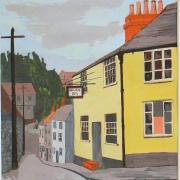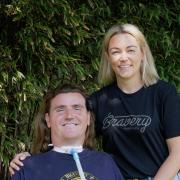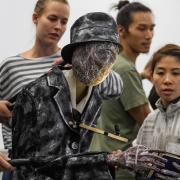Jeremy Miles meets some famous household names at a Tony Hancock Appreciation Society dinner as they reminisce about Bournemouth's most lugubrious star
Hancock’s Bournemouth Heritage
Jeremy Miles meets some famous household names at a Tony Hancock Appreciation Society dinner as they reminisce about Bournemouth’s most lugubrious star.
I’m standing in a Bournemouth hotel holding Tony Hancock’s trademark black Homburg hat, and talking to veteran actress June Whitfield about the enduring appeal of the late comic genius. Sitting on the sofa beside us are Hancock’s brilliant collaborators, the writers Ray Galton and Alan Simpson. They’re sharing memories with former Radio Times photographer Don Smith about his many photoshoots with the lugubrious star.
Am I dreaming? No, these four old friends may have a combined age of around 330 years but they’re still very much alive and kicking, and have made the annual pilgrimage to Bournemouth to pay homage to the one of the greatest comedians of the 20th century. Hancock references abound. There are scrapbooks, photographs and a few original props, including the aforementioned hat.
The troubled star, who committed suicide in 1968, originally found fame with the Galton and Simpson-penned sit-com Hancock’s Half Hour. It ran for 100 episodes on radio and 76 on TV before spawning a one-man spin-off called simply Hancock. Based on the life and times of a pompous, misanthropic, down-at-heel suburbanite, the character of Anthony Aloysius St John Hancock caught to perfection the prevailing mood of post-war austerity. Classic episodes like The Blood Donor, The Radio Ham and Sunday Afternoon at Home remain pure comedy gold.
But despite his success, Hancock was dogged by depression and self-doubt. He fell out with Galton and Simpson and struck out alone with disastrous consequences. As his star gradually waned, his scriptwriters went on to even greater success with Steptoe and Son. Hancock hit the bottle and finally died alone and deeply depressed while desperately trying to revive his flagging career in Australia. His body was found in his Sydney hotel room. Empty bottles of pills and vodka were by his side along with a note that read “Things just seemed to go too wrong too many times”.
It was a dreadful and lonely end for a man who had brought so much joy, but happily his legacy lives on and it is no accident that all those attending the annual Tony Hancock Appreciation Society dinner, in Bournemouth, dwell not on his death but on his life.
“Poor Tony, he certainly had a dark side,” agrees June Whitfield. “In many ways he was his own worst enemy. I remember once recording a series with him and we were sitting waiting for a cue and he suddenly said ‘What’s it all about, eh?’ I said ‘I’ve no idea Tony but we’re on in five minutes.’ He was a lovely man but I don’t think he ever realised how much everyone thought of him.”
Making light of their falling out over the comedian’s grandiose plans for his second film - “He wanted re-writes and we had a living to make” - Galton and Simpson say the Tony Hancock they first worked with was a delight. “We never had any problems with him. He was a pussycat,” says Ray Galton. For all these people – whether colleagues or fans – being in Bournemouth, close to the places that Hancock knew so well during his formative years, is a way of connecting with a lost friend.
His fictional address, 23 Railway Cuttings, East Cheam, is indelibly burned into the public psyche. Born in Hall Green, Birmingham in 1924, the real Tony Hancock arrived in Bournemouth in 1927 aged three when his hotelier parents took over The Railway Hotel in Holdenhurst Road (now the site of an Asda car park). When his father died in 1934, his mother re-married, and the family (Tony and his brothers Colin and Roger) moved to the Durlston Court Hotel in Gervis Road, which curiously was named after the school in Swanage which the young Hancock attended. Although it has undergone several changes of name (now known as Hotel Celebrity), there is still a plaque beside the front door marking its connection with the great comic.
Hancock spent much of his childhood watching entertainers at the nearby Pavilion Theatre. Increasingly fascinated by the world of showbusiness, he decided he wanted to become a professional entertainer. In 1940 he finally made his stage debut in the hall of the Church of the Sacred Heart on Bournemouth’s Richmond Hill. Billing himself ‘The Confidential Comic’, he had formulated a stand-up act that was heavy on innuendo. It was a disaster. The audience were shocked and the priest asked him to leave. A lesson was learned and Hancock never told another blue joke.
His first professional engagement was a few weeks later at the Labour Halls (now the Avon Social Club) in Springbourne, Bournemouth. Last year celebrity Hancock fans, actor Richard Briers and former Kinks guitarist Dave Davies, visited the club to unveil a plaque commemorating the start of the then 16-year-old comedian’s career. Other well-known Hancock aficionados include the comedian Paul Merton and controversial musician Pete Doherty of the Libertines, who named their first album Up the Bracket after one of Hancock’s catchphrases, while his song Lady Don’t Fall Backwards shares its title with the library book featured in one of the comedian’s best known TV episodes. Meanwhile Dorset-raised singer-songwriter Al Stewart’s biggest hit Year of the Cat started life as a song about Tony Hancock called Foot of the Stairs.
At this year’s annual dinner at the Queens Hotel, just a few hundred yards from the old Durlston Court, memories were rife of how Hancock arrived at the BBC fresh from Bournemouth via the RAF. It was 1951 and Ray Galton and Alan Simpson, who had met while receiving treatment in a TB sanatorium, were working on radio variety show sketches. By chance the young Hancock was cast in one of their pieces and liked their style, as Ray recalls. “He came up to us afterwards and said ‘Did you write that?’ We weren’t sure whether to admit to it or not but we told him yes, we had written it. He just looked at us and said: ‘Very funny!’ and walked off. I suppose that was our first review.”
The die was cast and soon Galton and Simpson were commissioned to write a series that would change the history of comedy. More than 60 years after they first started writing together these wily octogenarians still spark off each other with rare brilliance. “We’re a great team,” said Alan. “We help each other a lot. He helps me to get up the stairs and I help him to remember what day it is!” n
For more information about the Tony Hancock Appreciation Society visit tonyhancock.org.uk


























